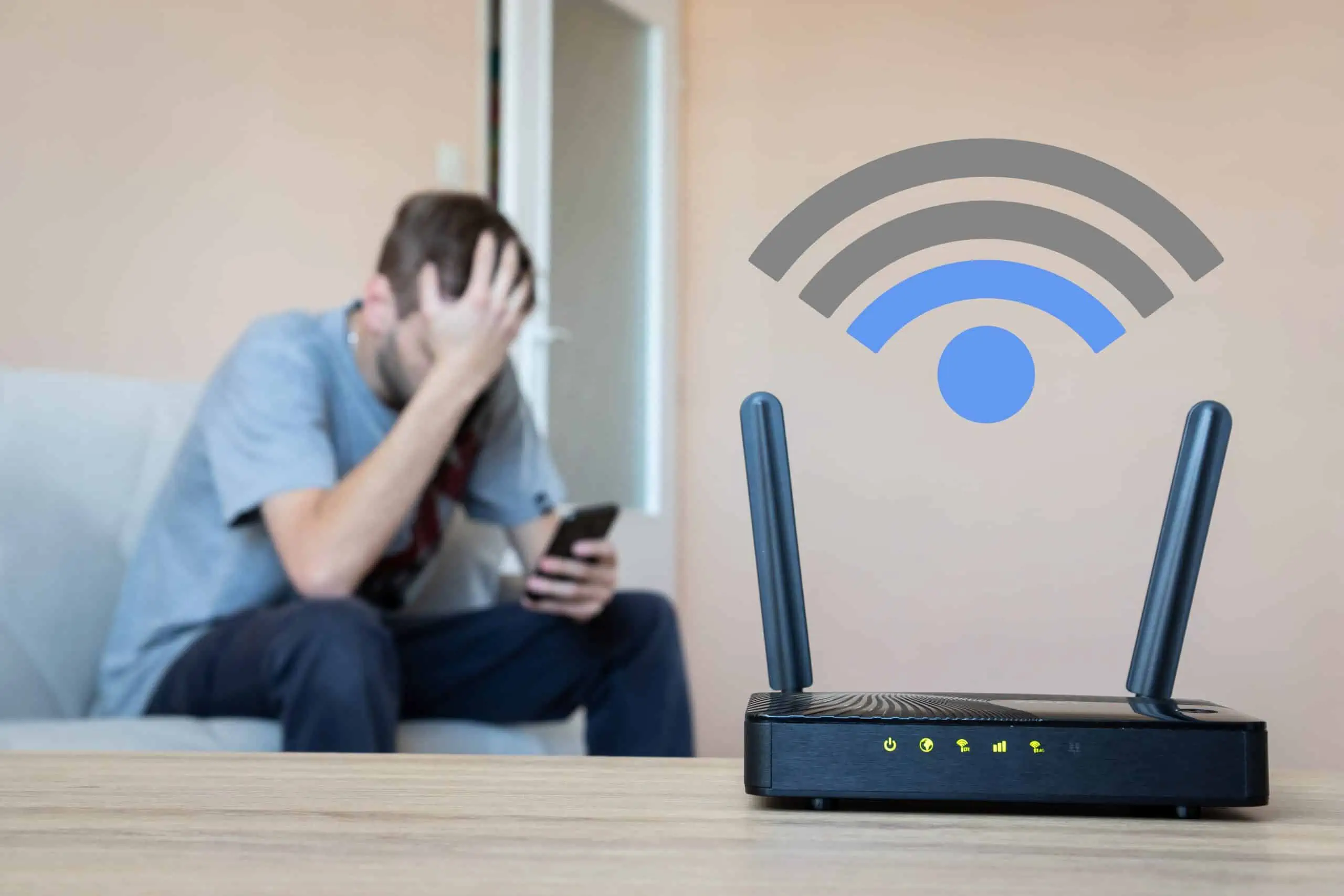What’s Up With The WiFi? Some Ideas To Solve Common Issues

Do you ever find yourself asking:
Why is my WiFi so slow?
Why is my internet so bad?
What can I do about my rubbish WiFi connection?
WiFi is a staple technology of the modern age, an everyday tool used by billions of people and devices around the world – it has become integral to day-to-day lives both on a personal and business level. In 2016, the United Nations even declared the Internet as a basic human right.
So why is it still so hard to get your WiFi networks and Internet connections working properly?!
A recent study by Censuswide (www.censuswide.com) of 1,001 small and medium enterprise staff showed that a whopping 706 (70.5%) suffer productivity problems in the workplace due to unreliable internet connections. That equates to nearly 2 and a half hours of disruption in an 8-hour working day! The cost of upgrading your network could very quickly be recovered by bringing productivity potential back up to 100% if employees are able to use ALL of their working hours for work instead of problem solving.
Many people often believe (including 53% of those surveyed) that this is down to their Internet Service Provider (ISP) – however there are lots of things you can try yourself before resorting to paying to get out of expensive contracts or switching to another provider in hope of a better service. It can often be more to do with the WiFi hardware being used and how it is being deployed.
In this guide, we’ll be outlining some of the common reasons that you might be experiencing slow WiFi problems, bad WiFi signal and other WiFi issues, and stop you wondering “why is my internet so slow?”. We’ll also be providing some tips on best WiFi practices and how to fix slow WiFi, which you can hopefully try before more drastic measures to improve your internet slowness, such as switching a “the best” Internet Service Provider.
Hop to a Topic
Outdated or Basic WiFi Hardware
When you sign up with internet services, your ISP will usually send you an entry-level piece of hardware that’s a jack of all trades. Despite their best efforts to convince you in their advertising they’re offering the “best hub ever”, it is usually dated and always something you should look to swap out – especially for the benefit of your business, employees, and customers!
The ISP’s default routers are usually already aged tech from the day they begin sending them out to their customers. You’ll likely miss out on many recent beneficial hardware advances and software options. Your simple WiFi problems, such as bad coverage or sluggish performance, may be solved simply by finding a higher-tier replacement.
If you have replaced these default devices but not for a while, then perhaps it’s time to investigate upgrading them again as you’re likely missing out on some key developments in the technology such as WiFi 6. “What is WiFi 6?” I hear you ask. As well as having 2.5 times the speed of the previous technology, the industry’s focus of WiFi 6 as a technology has been all about solving connection reliability and stability issues.
Even as this article was being written, Cisco had announced the latest update to WiFi technology, – WiFi 6e – moving WiFi technology in to the 6GHz band. It shows how quickly things can move on.
We’ll be providing deeper insight on some of these technologies in this article to help you self-diagnose your network and give a clearer view on how this technology can benefit you.
Obstacles, Walls and Other Obstructions Blocking WiFi Signal
It may seem obvious, but if you have a lot of physical obstructions between your devices and the access point you are going to experience a slowdown in the data transfer. Your device may be showing a strong signal, but this may not be a true reflection of the network’s conditions as physical obstructions can cause packet loss – essentially the data “hits” an obstruction and never makes it to its destination, i.e. your device.
WiFi signal is measured in decibels, the same measurement unit as is used to measure sound levels. If you think of WiFi signal in the same way this concept makes more sense.
Let’s say your neighbour is playing very loud music and you can hear the thud of the bass and a semblance of melody through the walls. You know there is loud music playing because your ears tell you there is, but you’re not able to make out which song is playing because you can’t hear it clearly enough.
This is much like the way your device reports WiFi – it can “hear” a lot of WiFi “noise” but it’s only “hearing” 20-30% of what’s going on due to the obstructions. It shows full signal bars because the WiFi is “loud”, but the reality is it’s not correctly “hearing” what is actually “playing”.
The simple solutions are to remove obstacles where possible, move the access point to a more central area with clearer air space, mount your access point up high above desks, furniture and people, or beef up your network with some additional access points around the premises. Appreciating it isn’t going to be possible to move a wall or certain fittings, it will very much depend on your specific environment as to what you can choose to rearrange, but the good news is it’s relatively easy to fix, or to at least work out if that’s one of the main issues.
Already using multiple APs? Well – that could be the source of one or two other issues as well!
Poor Deployment or Setup of Multiple WiFi APs
As we have briefly touched on, improving signal around awkward spaces can be as simple as adding WiFi boosters/extenders or additional access points to your network, bringing good signal to areas that previously couldn’t get it. Some products connect directly to a WiFi signal and re-broadcast, and some are hard-wired solutions – either through Ethernet or through the electrical ring main of a building – to pass signal elsewhere.
In a lot of cases this can work just fine but be aware of some of its own potential drawbacks, such as having a second WiFi network called “Original WiFi Name – EXT” and therefore another WiFi password to remember and a separate interface to the main access point to manage the device. Although they may have a simple setup process, they can be very tricky to get working to their full potential and may even further hinder your network if deployed incorrectly.
If using a wireless booster, the re-broadcasted signal will only be as good as the signal it receives, so if you put it right on the edge of your WiFi range where it only gets a slow download speed of 1Mbps out of a possible 50Mbps at source, it is only re-sharing 1Mbps to devices that connect to it. If half of your devices are connected to this second access point, they will all be sharing this slow connection of 1Mbps, instead of the full 50Mbps the original AP offers.
Another example: you may have tried to rename the secondary AP’s WiFi name to the same as the original so that no new WiFi passwords need to be entered into any device. This generally works if the signal of both AP’s does not operate in the same airspace, however, if a user’s device can be caught in the middle of 2 or more APs using the same network name (SSID) the device can get confused about where it’s sending and receiving data to and from. You may have heard this referred to as packet loss, where chunks of data seem to go missing in transit.
Depending on settings, your device may keep retrying the request and eventually make it through. This manifests to the user as simply a slow internet connection, leading to an assumption it’s the Internet connection itself as the problem rather than the hardware.
It’s all about finding the correct distance from the original access point to reduce “noisiness” of airspace, whilst providing good connectivity speed to the secondary access point. For this reason, it usually yields better results to use a wired connection from the original AP to the secondary, either through the ring main or a wired Ethernet connection, and doing your best to ensure the WiFi networks do not occupy the same airspace if possible. If these things aren’t really possible, it’s time to consider upgrading to dedicated multi-access hardware – sometimes know as Mesh.
Too Many Devices Connected at Once
Many access points, are simply not designed to take on more than a few connections at a time. Whilst the hardware may officially claim to be capable of 50 active connections for example, their ability to manage the traffic across those 50 connections is usually not up to scratch – especially if lots of the devices demand a lot of data.
We’ve all been there, happily watching a YouTube video and out of nowhere you’re faced with the spinning buffering wheel, and you think to yourself “why is my Internet so slow all of a sudden?” – you then realise that someone in another room has decided to download a new app or watch a video on their device, sucking up all the bandwidth.
If you’re suffering with slow internet speeds or high latency problems across multiple devices, try disconnecting any unused or non-essential devices from your network to see if there’s an improvement. It’s even worth trying disconnecting all but one device to trial this. If you notice considerable differences when reducing the number of connected devices, it’s time to consider upgrading – the hardware simply isn’t up to scratch.
There is a technology called MIMO – multiple input, multiple output – which is deployed on more premium access points. Often you see this described as MIMO 2×2, MIMO 3×3 or MIMO 4×4. But what is MIMO and what does MIMO do? The number, for example 4×4, is the number of 2-way channels the AP can open at one time, giving devices their own dedicated bandwidth and uninterrupted channels. 2×2 is 2 channels, 3×3 is 3 channels and so on. If one channel is blocked or stops, other channels can be used instead so that connectivity remains, or you can dedicate specific channels to specific devices or device types.
Think of it like a 4-way road junction with each side operating 4 lanes of traffic. With no officer or lights there to control the traffic, the cars would all end up doing what they wanted, blocking and crashing into each other trying to get across as quickly as possible. MIMO is your access point’s traffic officer, stood in the middle of the junction, making sure all the traffic gets through unscathed, in good time and keeping the traffic constantly flowing. You might be thinking “why do I need MIMO?” – simply put: the more controlled lanes of traffic you have open, the quicker everyone gets where they need to be.
High Traffic Users or Devices
Perhaps there are some specific users or devices on your network that need to use a lot more network traffic, for example a backup system that sends to a remote site over the internet, or a particular device that’s used to download or stream a lot of content regularly. When these devices are on the same network as everyone else, they can easily dominate all the available bandwidth, rendering all other devices extremely slow – or the opposite – they simply don’t get enough bandwidth when sharing with other devices to do their job properly.
You can try to create an entirely separate WiFi network for these devices. You then simply connect high-demand devices to one network, and everything else to the other to reduce sheer traffic volume on each network. Unless you have access to some more advanced settings though, such as the option to restrict or balance bandwidth to a network, you may find that the AP may still give all it’s resource to the most demanding device regardless of the network it’s connected to with no performance gain.
So how do you get around this? For true control over your network, more advanced networking devices are needed – allowing you granular control to each device and network giving everything exactly what it needs to create a very balanced network. This technology goes hand-in-hand with MIMO, using both together is a very powerful solution.
How can TECD Solutions Help?
We hope that you have found at least one of our explanations and solutions successful for you. We, more than most, understand the frustration that comes with networking issues and there can be so many reasons why things aren’t working it makes you want to do nothing at all!
At TECD Solutions we are specialists in designing, configuring, deploying and maintaining computer networks, ranging from one-off small building deployments right up to international multi-office connectivity.
We are currently offering a FREE WiFi auditing service around Hampshire, Berkshire and Surrey to help SMEs and local businesses to optimise their WiFi networks, solve persistent connectivity and reliability issues and also demonstrate where having a well-managed network can improve your bottom line.
If you’re having issues with your WiFi or wider network, or simply want a consultation on up-to-date network technology and how it can benefit your business, please don’t hesitate to get in touch!
Send an enquiry through the below form and we’ll get back to you at your convenience.


